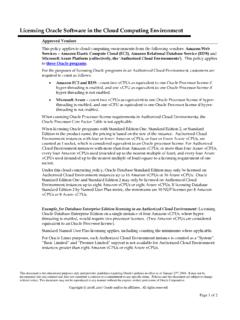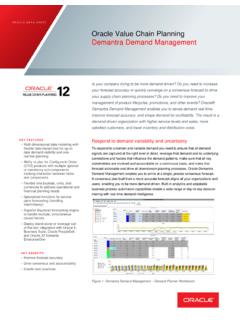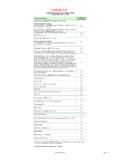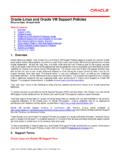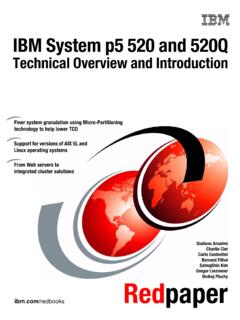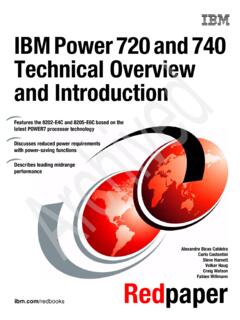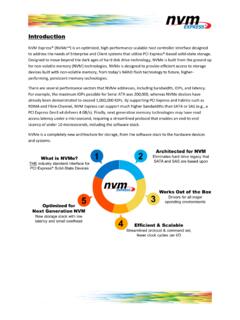Transcription of Exadata Hybrid Columnar Compression (HCC) on Exadata
1 An Oracle White Paper November 2012 Hybrid Columnar Compression (HCC) on Exadata Introduction .. 3 Hybrid Columnar Compression : technology overview .. 4 Warehouse Compression .. 5 Archive Compression .. 7 Migration and Best Practices .. 9 Conclusion .. 11 Hybrid Columnar Compression on Exadata 3 Introduction Hybrid Columnar Compression on Exadata enables the highest levels of data Compression and provides enterprises with tremendous cost-savings and performance improvements due to reduced I/O. HCC is optimized to use both database and storage capabilities on Exadata to deliver tremendous space savings AND revolutionary performance.
2 Average storage savings can range from 10x to 15x depending on which Hybrid Columnar Compression level is implemented real world customer benchmarks have resulted in storage savings of up to 204x. With average storage savings of 10x from HCC, IT managers can drastically reduce and often eliminate their need to purchase new storage for several years. For example, a 100 terabyte database achieving 10x storage savings would utilize only 10 terabytes of physical storage. With 90 terabytes of storage now available, IT organizations could potentially delay storage purchases for a significant amount of time.
3 The 90 terabytes of storage could even be used to store up to 9 more databases with 100 terabytes of data compressed to 10 terabytes of actual disk space each. Hybrid Columnar Compression is an enabling technology for both Warehouse Compression and Archive Compression . We will discuss each of these capabilities in detail later in this paper, but first let s explore the implementation/benefits of Hybrid Columnar Compression on Exadata the next generation in Compression technology . Hybrid Columnar Compression on Exadata 4 Hybrid Columnar Compression : technology overview Traditionally, data has been organized within a database block in a row format, where all column data for a particular row is stored sequentially within a single database block.
4 Having data from columns with different data types stored close together limits the amount of storage savings achievable with Compression technology . An alternative approach is to store data in a Columnar format, where data is organized and stored by column. Storing column data together, with the same data type and similar characteristics, dramatically increases the storage savings achieved from Compression . However, storing data in this manner can negatively impact database performance when application queries access more than one or two columns, perform even a modest number of updates, or insert small numbers of rows per transaction.
5 Oracle s Hybrid Columnar Compression technology is a new method for organizing data within a database block. As the name implies, this technology utilizes a combination of both row and Columnar methods for storing data. This Hybrid approach achieves the Compression benefits of Columnar storage, while avoiding the performance shortfalls of a pure Columnar format. A logical construct called the Compression unit is used to store a set of Hybrid Columnar -compressed rows. When data is loaded, column values for a set of rows are grouped together and compressed. After the column data for a set of rows has been compressed, it is stored in a Compression unit.
6 Conceptual Illustration of a Logical Compression Unit To maximize storage savings with Hybrid Columnar Compression , data must be loaded using data warehouse bulk loading techniques. Examples of bulk load operations commonly used in data warehouse environments are: Insert statements with the APPEND hint Parallel DML CU HEADER BLOCK HEADER BLOCK HEADER BLOCK HEADER BLOCK HEADER C3 C4 C1 C2 C7 C5 C6 C8 C8 Compression Unit Hybrid Columnar Compression on Exadata 5 Direct Path SQL*LDR Create Table as Select (CTAS) Queries on Hybrid Columnar compressed data often run in the Exadata storage cells with Smart Scans, using a high performance query engine that utilizes special Columnar processing techniques.
7 Data sent back to the database server(s) is usually compressed (and is typically much less data than is read from disk) and the compressed data is subsequently processed by the database server(s). Note that data remains compressed not only on disk, but also remains compressed in the Exadata Smart Flash Cache, on Infiniband, in the database server buffer cache, as well as when doing back-ups or log shipping to Data Guard. One of the key benefits of the Hybrid Columnar approach is that it provides both the Compression and performance benefits of Columnar storage without sacrificing the robust feature set of the Oracle Database.
8 For example, while optimized for scan-level access, Oracle is still able to provide efficient row-level access, with entire rows typically being retrieved with a single I/O, because row data is self-contained within Compression units. In contrast, pure Columnar formats require at least one I/O per column for row-level access. With data warehousing tables generally having hundreds of columns, it is easy to see the performance benefits of Hybrid Columnar Compression on Exadata . Further, tables using Hybrid Columnar Compression on Exadata still benefit from all of the high availability, performance, and security features of the Oracle Database.
9 Note that while data in Hybrid Columnar compressed tables can be modified using conventional Data Manipulation Language (DML) operations - INSERT, UPDATE, DELETE - performing such operations could result in a reduction of the HCC Compression ratio. It is recommended that HCC be enabled on tables or partitions with no or infrequent DML operations. If frequent DML operations are planned on a table or partition, then the Oracle Advanced Compression Option is better suited for such data. Warehouse Compression Data warehouses have become increasingly important in the day-to-day operations of enterprises.
10 They are responsible for storing significant amounts of data, transforming that data into strategic information, and providing management with the necessary intelligence to run the enterprise. As the importance of data warehouses has increased, so too has the amount of data managed by data warehouses. With data volumes often doubling every two years, IT Managers are experiencing significant challenges both in storage costs and application query performance. Warehouse Hybrid Columnar Compression on Exadata 6 Compression is the next-generation Compression feature dedicated to solving both of these challenges.

